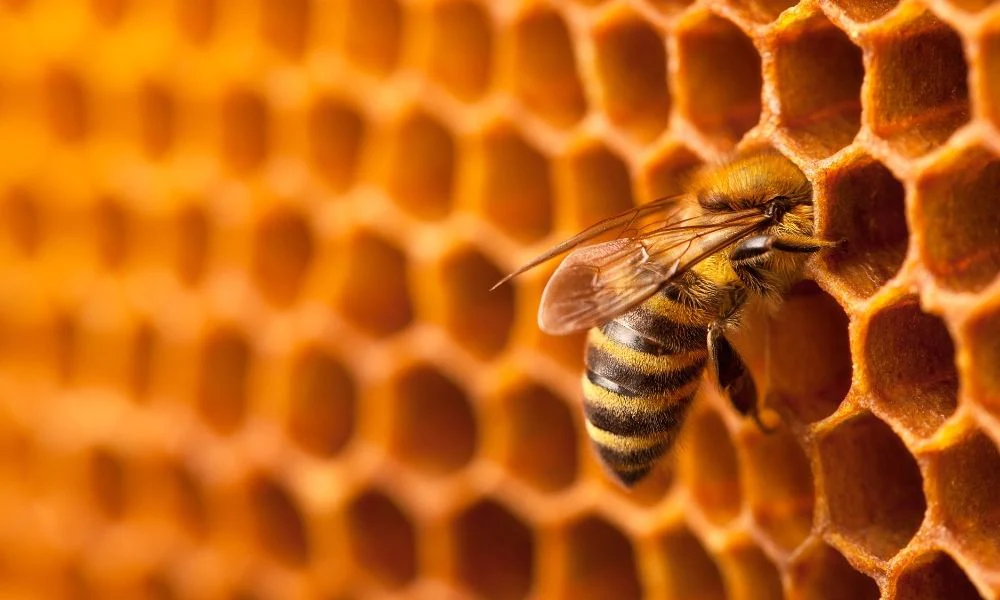Honeycomb is one of nature’s most fascinating and intricate creations. Made by honey bees, honeycomb serves as both a home and a storage facility for honey and pollen. Its hexagonal cells are a marvel of engineering efficiency, providing strength and stability while using minimal materials. In this article, we will explore the structure, function, production, and significance of honeycomb.
Structure of Honeycomb
Honeycomb is composed of numerous hexagonal cells arranged in a close-packed pattern. These cells are made from beeswax, which is produced by worker bees. The hexagonal shape is the most efficient way to fill space with the least amount of material, making it an optimal choice for bees to construct their combs.
Each cell has six sides, with three meeting at each vertex. This arrangement maximizes the use of space and provides structural integrity to the comb. The walls of the cells are extremely thin, yet they are able to support the weight of the honey stored inside.
The entire honeycomb structure is suspended from the top of the hive or nest, with each cell hanging vertically. This orientation allows gravity to assist in the drainage of honey from the cells when needed.
Function of Honeycomb
Honeycomb serves several crucial functions for honey bees:
Storage: The primary function of honeycomb is to store honey, pollen, and bee brood (eggs, larvae, and pupae). Honey bees collect nectar from flowers and store it in the cells of the comb, where it is converted into honey through a process of evaporation and enzymatic action. Pollen, which serves as the bees’ protein source, is also stored in separate cells within the comb.
Nesting: Honeycomb provides a secure and organized space for the colony to raise its young. The cells of the comb act as individual chambers for each developing bee, with eggs laid by the queen bee in specific cells designated for brood rearing.
Temperature regulation: The hexagonal shape of the cells allows for efficient circulation of air within the comb, helping to regulate temperature and humidity levels. This is critical for maintaining the health and well-being of the colony, as bees are highly sensitive to changes in environmental conditions.
Production of Honeycomb
The production of honeycomb is a remarkable feat of collaboration among worker bees within the colony. The process begins with the secretion of beeswax from special glands located on the abdomens of worker bees. The beeswax initially appears as small flakes or scales, which the bees chew and manipulate with their mouthparts to soften and shape into the characteristic hexagonal cells of the comb.
Worker bees work together in a coordinated fashion to construct the comb, with each bee contributing to the building process. The construction of honeycomb is a labor-intensive task that requires precise measurement and alignment of the cells to ensure structural integrity.
Once the comb is complete, it is used for storing honey, pollen, and brood, as described earlier. As the colony grows and requires additional storage space, the bees will continue to build new comb as needed.
Significance of Honeycomb
Honeycomb plays a vital role in the survival and success of honey bee colonies, as well as in the larger ecosystem. Here are some of its key significance:
Pollination: Honey bees are important pollinators of many flowering plants, including numerous crops that are essential for human food production. The construction of honeycomb provides a nesting habitat for bees, allowing them to build and maintain strong colonies that can effectively pollinate crops and wildflowers.
Honey production: Honey produced by honey bees is not only a delicious and nutritious food source for humans but also an important economic commodity. The construction of honeycomb enables bees to store and preserve honey for long periods, allowing beekeepers to harvest surplus honey for human consumption.
Biodiversity: Honeycomb serves as a habitat for a diverse array of organisms within the hive, including bacteria, yeasts, and other microorganisms that play roles in honey production and hive health. Additionally, honeycomb provides shelter for other insects and small creatures that may inhabit the hive alongside the bees.
Cultural significance: Honey has been prized by humans for thousands of years for its sweetness, flavor, and medicinal properties. Honeycomb, with its association with honey production, has cultural significance in many societies around the world, where it is used in traditional foods, rituals, and ceremonies.
Conclusion
Honeycomb is a remarkable example of nature’s ingenuity and efficiency. Its hexagonal structure, formed from beeswax by the collective efforts of honey bees, serves as a multifunctional marvel that supports the health and productivity of bee colonies and ecosystems. Understanding the structure, function, production, and significance of honeycomb deepens our appreciation for the vital role that bees play in the natural world and highlights the importance of protecting and preserving their habitats.







